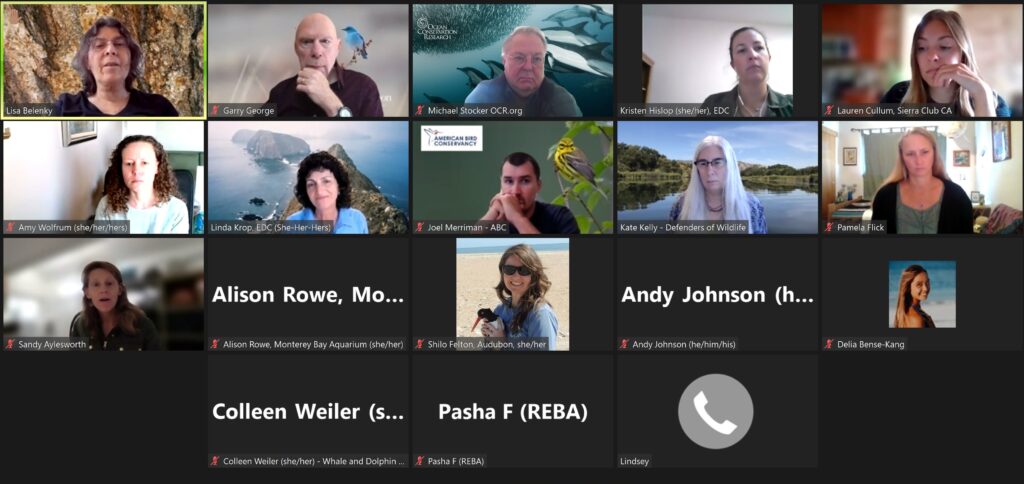
Typical offshore wind Zoom meeting
When I first started working on marine conservation issues back in 1992, the working rooms were mostly filled with guys in suits. Regulators, academics, naval personnel, lawyers. and conservationists. We each had our agendas, and strategies, and while there was “team spirit” amongst the various conservation groups, most conservation efforts were done on behalf of each of our respective organizations.
So in 2000, when I was submitting public comments to the US Navy Low Frequency Active Sonar proposal, I submitted them on behalf of “Seaflow,” a small community conservation organization for which I was serving as “Science Advisor.” There were some women around – Cara Horowitz with NRDC, Naomi Rose with (at the time) Humane Society US, and Susan Millward of Animal Welfare Institute all come to mind. But each of us focused our efforts on strengthening our particular organization’s bona fides by submitting our comments under our organizational letterheads.
And for the last twenty years it has largely been like this – with a recent variation being “group sign-on letters” offered up for endorsement by one or another organization’s comments to an Environmental Impact Statement (EIS).
During the Trump years, when the conservation habitat was constantly a three-alarm fire, this ‘endorsement’ idea was perverted by some organizations into a glorified petition. Certain groups would write pithy comments to an EIS and ask their ‘members’ to submit it to “Regulations.gov” as a show of support – but also as donation bait for the organization.
This resulted in often millions of “public comments” completely cluttering up the process. With so many comments to synthesize, the agencies were left no choice than to have them “read” and sorted by scanners. I never got a clear answer from any of the agencies about how they segregated qualified, expert comments from the hash, but my suspicions are that if words used in the expert comments were not included as “search terms” in their scan, they were not really incorporated into the record. So in our case terms like “sound propagation,” or any mathematical modeling used to substantiate an argument would not necessarily be incorporated into any proposed revisions of the EIS.
As informing revisions was the purpose of our comments, I always wondered if I was just wasting a lot of my time.
But with this recent rash of offshore wind comments, the profile has changed significantly. I didn’t get the memo, but the National Wildlife Federation and Defenders of Wildlife have funded coordinated, collaborative efforts to submit comments on all of these offshore wind projects flying around. While there have been enough Zoom meetings to give us all whiplash, we have also been pulling together some substantial recommendations and critiques for each of the many projects.
With the collective expertise of folks from NRDC, Audubon, Environmental Defense, Surfrider, SELC, American Bird Conservancy, Monterrey Bay Aquarium, The Nature Conservancy, Oceana, and a handful of others, we are submitting deep, thorough, and meaningful responses to documents from the Bureau of Ocean Energy Management (BOEM).
Having all of our various concerns addressed comprehensively in a unified document makes it easier BOEM to track, and less likely to get lost in the process. But what is also really clear is that these collaboration meetings are majority women. By a lot. Today I was one of four men in a 20-person meeting.
Is there a correlation between female leadership and collaboration? I can’t say for sure. But I would bet that had we been running these collaborative EIS comment meetings twenty years ago, we would have avoided a lot of extra work, and a whole lot of grief.

